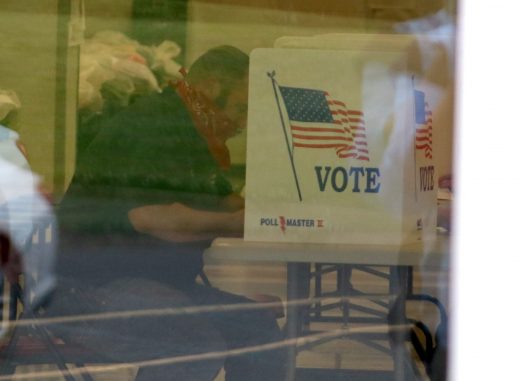By Nick Field | Pennsylvania Capital-Star

Map by Nick Field via Dave’s Redistricting
Off-years, or odd-numbered years, tend to be favorable for the party out of the White House, and 2023 looks to be no exception.
Since my last voter registration update in October 2022, Pennsylvania Republicans saw impressive gains all across the Commonwealth. Back then, the statewide Democratic margin was 549,288, a lead that’s since been whittled down to 445,890, constituting a shift of 103,398 towards the Pennsylvania GOP.
As I’ve noted many times before, given the historical Democratic advantage, the GOP always tends to pick up ground, except during the most Dem-favorable of times. Nevertheless, this degree of a shift is still notable.
So what exactly can these trends tell us ahead of Election Night 2023 and the 2024 Presidential cycle? Well, let’s dive in and find out!
A quick note: I explore our changing voter trends by tracking the gains one party accumulated in registrations over the other party. For example, R+500 means that the Republican Party gained a net 500 more registered voters in that county than the Democratic Party did over this period, while D+500 indicates the opposite.
Central
- Blair: R+319
- Bradford: R+130
- Cameron: R+82
- Centre: R+1,217
- Clearfield: R+764
- Clinton: R+573
- Columbia: R+557
- Elk: R+555
- Huntingdon: R+384
- Juniata: R+108
- Lycoming: R+355
- McKean: R+197
- Mifflin: R+188
- Montour: R+137
- Northumberland: R+1,053
- Potter: R+193
- Snyder: R+117
- Sullivan: R+64
- Tioga: R+248
- Union: D+38
Traditionally Centre County, home to Penn State University, is the sole blue island amidst a sea of red in the central part of the Commonwealth. This time, though, the exception is Union County, home to Bucknell University. That county has been trending to the left since the dawn of the Trump Era, and this map is just the most glaring example yet of this movement.
Northeast
- Carbon: R+864
- Lackawanna: R+2,836
- Luzerne: R+3,986
- Monroe: R+1,479
- Pike: R+656
- Schuylkill: R+1,321
- Susquehanna: R+214
- Wayne: R+362
- Wyoming: R+136
Pennsylvania Republicans have been picking off registrants for a quarter-century now in the once solidly Democratic Scranton/Wilkes-Barre corridor that runs through Lackawanna and Luzerne Counties. Yet in spite of this, candidates Josh Shapiro and John Fetterman both performed quite well here last year, far better than even “Scranton” Joe Biden did in 2020. As a result, this is one area I’ll be watching closely on Nov. 7 to get a read on the mood here ahead of 2024.
Northwest
- Clarion: R+301
- Crawford: R+639
- Erie: R+2,989
- Forest: R+81
- Jefferson: R+227
- Mercer: R+1,440
- Venango: R+257
- Warren: R+484
The Northwest corner of the Commonwealth is home to win one of Pennsylvania’s two Obama-Trump-Biden counties. In fact, since Trump’s 2016 upset, political observers consider this lakeside county to be a statewide bellwether. Nevertheless, Democratic nominees in nearly every major race are winning Erie, even as the GOP continues to post gains there. At some point, one of these two trends will have to give way to the other.
South Central
- Adams: R+355
- Bedford: R+194
- Cumberland: D+282
- Dauphin: R+1,458
- Franklin: R+337
- Fulton: R+216
- Lancaster: R+62
- Lebanon: R+373
- Perry: R+187
- York: R+1,860
Much like Union was the outlier in Central Pennsylvania, Cumberland is the outcast in South Central Pennsylvania. Thanks to the well-educated suburbs across the river from Harrisburg, Democrats are slowly but surely gaining ground in this traditionally Republican county. Last year Gov. Josh Shapiro managed to win it, although Fetterman came up short in the Senate contest. Such a split result suggests that Cumberland County could very well become a 2024 Presidential battleground.
On the other hand, despite the recent Democratic trends in places like Dauphin and Lancaster, the GOP was able to turn the tide there. The Republicans also continued to rack up considerable numbers in York County, the Big Red Machine of the Keystone State.
Southeast
- Berks: R+3,937
- Bucks: R+3,497
- Chester: D+104
- Delaware: D+898
- Lehigh: R+2,969
- Montgomery: R+430
- Northampton: R+2,349
- Philadelphia: R+26,040
Altogether, these are probably the most distressing numbers of all for Pennsylvania Democrats, given just how dependent they’ve grown on large margins out of Philly and its collar counties. Even Montgomery County, Shapiro’s hometown turf, saw a small loss this past year. In the end, only Chester and Delaware managed to stem the tide.
Meanwhile, Berks County – long the reddest of the Lehigh Valley trio – was also one of the two counties that flipped from a Democratic-pluality to a Republican-plurality over the past year. The reddest of the Philly collar counties, Bucks County, also saw a major swing to the GOP; although the Dems are still ahead there. Finally, Republicans made major gains in Northampton, Pennsylvania’s other Obama-Trump-Biden bellwether.
Southwest
- Allegheny: R+16,024
- Armstrong: R+549
- Beaver: R+2,097
- Butler: R+979
- Cambria: R+2,468
- Fayette: R+4,990
- Greene: R+745
- Indiana: R+726
- Lawrence: R+1,232
- Somerset: R+715
- Washington: R+2,368
- Westmoreland: R+3,820
Alongside Berks, Republicans also surpassed Democrats in Fayette County, one of the final vestiges of the ancestral Appalachian Democrats. The final Dem holdout among Allegheny’s neighbors is Beaver, where a narrow advantage is destined to disappear over the next few weeks.
All the while, the Pennsylvania GOP made gains not just in major red vote-engines like Washington and Westmoreland counties, but in Allegheny too. As a result, any statewide victories Republicans put together on Nov. 7 will be powered by colossal margins in this increasingly red Southwestern corner of the commonwealth.
Conclusion
So what does all this tell us? To what extent do voter registration trends predict actual election results?
Well, during the last off-year elections in 2021, Republican gains did eventually lead to victories that November. Furthermore, we also saw a clear post-Dobbs Democratic surge in the run-up to their better-than-expected performance in the 2022 midterms.
At the same time, the Pennsylvania GOP was optimistic that their 2020 registration gains were indications of another upset victory for Trump, which of course never came to pass. Therefore, we know that there’s no perfect correlation here.
We’ll just have to wait for the results, with this Nov. 7 election providing us with a fantastic survey of the commonwealth, from statewide judicial races to individual county contests. So let the lesson be that there are no real off-years.









